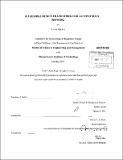| dc.contributor.advisor | Olivier L. de Weck. | en_US |
| dc.contributor.author | Kraft, Justin (Justin A.) | en_US |
| dc.contributor.other | System Design and Management Program. | en_US |
| dc.date.accessioned | 2012-05-15T21:13:43Z | |
| dc.date.available | 2012-05-15T21:13:43Z | |
| dc.date.copyright | 2011 | en_US |
| dc.date.issued | 2011 | en_US |
| dc.identifier.uri | http://hdl.handle.net/1721.1/70803 | |
| dc.description | Thesis (S.M. in Engineering and Management)--Massachusetts Institute of Technology, Engineering Systems Division, System Design and Management Program, 2011. | en_US |
| dc.description | Cataloged from PDF version of thesis. | en_US |
| dc.description | Includes bibliographical references (p. 93-95). | en_US |
| dc.description.abstract | This work outlines the creation of a flexible design framework for autonomous mowing to meet changing customer needs and functionality across a spectrum of applications from residential areas to sport complexes. The thesis has the objective of creating an optimized architecture to meet a range of functionality that delivers value in diverse customer mission segments. Additionally, autonomous mowing is supported by fast moving technology domains that create the need for technology selection strategies that anticipate future trends in critical metrics. Currently an early dominant design has been produced, but increasing competition is actively advancing the current state of the art for autonomous mowing. An analysis to determine where the value lies in the system, much like the evolution of the PC, determines when to shift between modular and integrated designs. As designs become modular and flexible the importance of knowing which areas of the system capture value and lead to revenue is critical for a company's continued success in the domain. Using this framework Pareto frontiers were developed using genetic algorithms that clearly show the sensitivity between manufacturing costs and total life cycle cost to the consumer using 970 generations. A platform architecture analysis provided a 9% increase in a portfolio Net Present Value by determining an optimum commonality and differentiation plan over that of individually optimized customer segment offerings. This analysis also determines if an open source approach to innovation is viable for increased customer satisfaction while supporting increased manufacturer revenues (Hippel, 2005). | en_US |
| dc.description.statementofresponsibility | by Justin Kraft. | en_US |
| dc.format.extent | 112 p. | en_US |
| dc.language.iso | eng | en_US |
| dc.publisher | Massachusetts Institute of Technology | en_US |
| dc.rights | M.I.T. theses are protected by
copyright. They may be viewed from this source for any purpose, but
reproduction or distribution in any format is prohibited without written
permission. See provided URL for inquiries about permission. | en_US |
| dc.rights.uri | http://dspace.mit.edu/handle/1721.1/7582 | en_US |
| dc.subject | Engineering Systems Division. | en_US |
| dc.subject | System Design and Management Program. | en_US |
| dc.title | A flexible design framework for autonomous mowing | en_US |
| dc.type | Thesis | en_US |
| dc.description.degree | S.M.in Engineering and Management | en_US |
| dc.contributor.department | System Design and Management Program. | en_US |
| dc.contributor.department | Massachusetts Institute of Technology. Engineering Systems Division | |
| dc.identifier.oclc | 792891151 | en_US |
